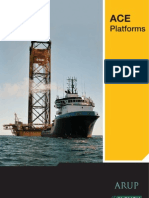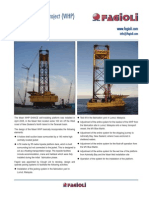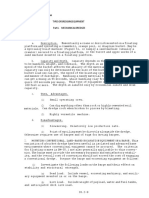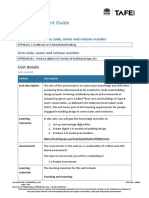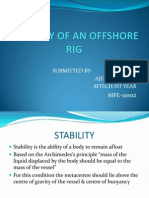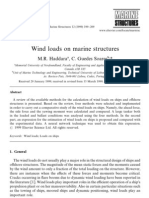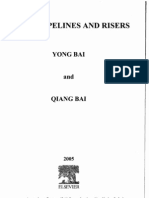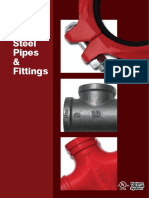Operation Liftboat Two
Operation Liftboat Two
Uploaded by
myusuf_engineerCopyright:
Available Formats
Operation Liftboat Two
Operation Liftboat Two
Uploaded by
myusuf_engineerCopyright
Available Formats
Share this document
Did you find this document useful?
Is this content inappropriate?
Copyright:
Available Formats
Operation Liftboat Two
Operation Liftboat Two
Uploaded by
myusuf_engineerCopyright:
Available Formats
Deck Cargo During Transit & Deck Cargo Not Allowed
During Transit
Lift Boats are regulated by USCG “Operations Manual” and Stability
Curve Guidelines generated by the Designing Naval Architect. Each Lift
Boat has its own “Maximum” Deck Load Capacity and Stability Curves.
Considerations For loading deck cargo:
a. Equally distribute load port to starboard and fore to aft.
b. Equipment to be connected by hoses must be within close
proximity of each other.
c. No tanks containing fluids during transit.
d. Specific equipment access requires appropriate walkway
clearance between stowed items.
e. Total amount of area available for stowage and fixed
appendages that may render certain areas useless except
for small compact items.
f. Available tie down fixtures .
g. Potential height restrictions in areas where crane booms
rest in racks for transit.
h. Deck cargo such as cantilever assemblies with coring
apparatuses that may be transported with the partial
assembly hanging over bow. This is evaluated on as
needed basis.
Deck Cargo Stowage, Passage Ways & Weight Distribution
Center Line Vessel
25,000 Lbs.
550,000 Lbs.
48” clearance where hoses
Will adjoin pumps and tanks.
25,000 Lbs.
Typical 30” Walkway Clearance
Soil Conditions, Pre-Load Times & Pad Retrieval
Pre-Load times will vary based on region.
a. Most Lift Boat companies maintain historical data regarding pad
penetration, if historical data is not available within your archives,
contact the chosen Lift Boat Operator and request pad penetration
depth and estimated pre-loading times.
b. Pre-Loading begins when the Lift Boat is elevated, to a height
where seas are not making contact with the bottom during pre-
loading. There is really no time limit on Pre-loading. As long as the
vessel’s pads continue to settle below mud line, Pre-Loading must
continue. Only after each pad has reached a static state for a
minimum of 2 hours, the vessel may dump it’s pre-load ballast and
jack up to the required working height.
c. Throughout Pre-Load Cycles, there can be no personnel, Crew
Members or Third Party Personnel on the Main Deck. Reason
being, if the vessel spontaneously settles in one direction, and
deck cargo shifts, personnel will not be in harms way. While
Jacking all personnel except for the Captain must be outside of the
quarters, with life vest on, on the 02 or wheelhouse level deck. If
your location entails a prolonged pre-loading time frame, it will be
beneficial to transit all third party contractors to location after pre-
loading and jacking to elevation has been achieved. Otherwise all
personnel will have to be standing throughout the entire process.
d. On locations where High Pad Penetration (20+ feet) is achieved, it
could possibly take 24- 48 hours to retrieve pads. These conditions
create additional concern during Hurricane Season. If a storm
develops within the Gulf and conditions deteriorate prior to the
Lift Boats ability to retrieve its pads and depart to a Safe Harbor,
the vessel will be forced to remian on location with a high
probability of being lost during the storm.
Sea conditions required for normal positioning & departure
Maximum sea conditions for positioning are between 3’ – 5’ depending on type and
direction of sea conditions.
1. A Lift Boat will be able to position in 4’ to 5’ sea conditions, only if the direction of seas are not
not impeding the captains ability to safely position the vessel around the structure and within
the confinement of surrounding pipelines.
2. The Lift Boat will difficulty maintaining position and tagging down in a 3’ – 5’ Side Sea
condition.
2. It is not possible for Lift Boats to approach and position on location with a trailing 3’ to 5’
sea condition. Lift Boats do not maneuver well backing to stern, against a current,
prevailing wind and/or sea state including swells.
Trailing Sea Condition,
pushing vessel into platform
Side Seas acceptable with most un-desirable condition.
minimal conditions
Side Seas acceptable with
minimal conditions
Can Holes from Drilling Rig.
Head Seas Conditions, most
desirable condition
Sea conditions required for positioning onto a congested
location
When precise positioning or positioning in a congested area is required, the current, wind, and sea
conditions must be calm.
1. The vessel is required to stay a minimum distance of 15’ from the pipeline, off of the
starboard pad.
2. There is a variable lateral and fore & aft allowance of 3’ as a result of the false
rotary assembly, that is suspended over the bow 10’ to support pile driving operations.
3. The vessel must be rotated slightly towards the port, to gain more room between the Lift Boat
leg and tri pod cluster, to allow for off loading piles from the support vessel.
You might also like
- T-Bar Vs CPTDocument8 pagesT-Bar Vs CPTFarid SaadNo ratings yet
- ACE Platforms 0801Document4 pagesACE Platforms 0801Ruslan ZakirovNo ratings yet
- Statement of Account: Statement Date Credit Limit Minimum Payment Payment Due DateDocument4 pagesStatement of Account: Statement Date Credit Limit Minimum Payment Payment Due Datemyusuf_engineerNo ratings yet
- Operation Manual: This Manual Also Covers The Seakeeper 7Hd ModelDocument35 pagesOperation Manual: This Manual Also Covers The Seakeeper 7Hd Modelmyusuf_engineer100% (1)
- Operation Liftboat ThreeDocument5 pagesOperation Liftboat Threemyusuf_engineer100% (1)
- Operation Liftboat FiveDocument4 pagesOperation Liftboat Fivemyusuf_engineerNo ratings yet
- OHT 5360 102 Transport Design Manual R00Document23 pagesOHT 5360 102 Transport Design Manual R00eNo ratings yet
- Anti-Piracy BMP5 and GCPGDocument10 pagesAnti-Piracy BMP5 and GCPGPetar AleksandrovNo ratings yet
- OCIMF Shore LinesDocument4 pagesOCIMF Shore LinesPeyman Mzn100% (1)
- SEACOR Power SRC Board Meeting SummaryDocument7 pagesSEACOR Power SRC Board Meeting SummaryAmanda JohnsonNo ratings yet
- Turret MooringsDocument3 pagesTurret Mooringsjo0% (1)
- Operation Liftboat FourDocument6 pagesOperation Liftboat Fourmyusuf_engineer100% (1)
- Bollard Pull Calculation Sheet Validation and User Guide: Additional InfoDocument10 pagesBollard Pull Calculation Sheet Validation and User Guide: Additional InfoaureliousNo ratings yet
- PUBS Loss Prevention Tug and Tow Safety and Operational Guide - A5 - 0715 PDFDocument90 pagesPUBS Loss Prevention Tug and Tow Safety and Operational Guide - A5 - 0715 PDFmulyadiNo ratings yet
- RP-H103 - Marine OperationDocument42 pagesRP-H103 - Marine OperationHoang LacNo ratings yet
- PIRACY - Questions & AnswersDocument7 pagesPIRACY - Questions & AnswersMónica AquinoNo ratings yet
- Suction Anchors in ClayDocument8 pagesSuction Anchors in ClayKleberson CarvalhoNo ratings yet
- SPM - Rules 2023 PDFDocument126 pagesSPM - Rules 2023 PDFbobuncle03No ratings yet
- 6002 Notes 08 L2Document34 pages6002 Notes 08 L2talabizNo ratings yet
- MaariDocument2 pagesMaarimyusuf_engineer100% (1)
- Tipe Perlengkap Pengerukan Types of Dredging Equipment Part 1. Mechanical DredgesDocument15 pagesTipe Perlengkap Pengerukan Types of Dredging Equipment Part 1. Mechanical Dredgesfathurahmad 2205No ratings yet
- Hornbeck Offshore Services IncDocument107 pagesHornbeck Offshore Services IncmdshoppNo ratings yet
- OLF - NSA Guidelines For Safe Handling and TowingDocument22 pagesOLF - NSA Guidelines For Safe Handling and TowingTomash VerbitskyNo ratings yet
- Cppbdn5101 UagDocument5 pagesCppbdn5101 Uagkarate hotNo ratings yet
- RINA - Developments in Heavy Transport Design CalculationsDocument12 pagesRINA - Developments in Heavy Transport Design CalculationsdsrfgNo ratings yet
- WILCKEN - Alpha Factors For The Calculation of Forecasted Operational LimitsDocument67 pagesWILCKEN - Alpha Factors For The Calculation of Forecasted Operational Limitskleidi85No ratings yet
- V.001 Vryhof Product Brochure STEVSHARK REX For WebDocument6 pagesV.001 Vryhof Product Brochure STEVSHARK REX For WebVinicius Prado100% (1)
- MooringSystemforVeryLargeShipsatBerth Paper ApurvaKudaleDocument10 pagesMooringSystemforVeryLargeShipsatBerth Paper ApurvaKudaleAndreManhaesNo ratings yet
- On The Practical Prediction Method For Ship Manoeuvring Characteristics 11Document3 pagesOn The Practical Prediction Method For Ship Manoeuvring Characteristics 11Fabio OkamotoNo ratings yet
- Submitted By-Ajendra Singh Mtech Ist YearDocument23 pagesSubmitted By-Ajendra Singh Mtech Ist YearaksasinghNo ratings yet
- SIW Issue 1476 11 - 06 - 2021Document20 pagesSIW Issue 1476 11 - 06 - 2021Carlos IrribarraNo ratings yet
- Heave Compensated Floatover Operation - F.E. WesterDocument139 pagesHeave Compensated Floatover Operation - F.E. Westermoechamad_aditia100% (1)
- Optimoor: Mooring Analysis So Ware For Ships & BargesDocument2 pagesOptimoor: Mooring Analysis So Ware For Ships & BargesTam Jun HuiNo ratings yet
- Global Wave Statistics For Structural DesignDocument111 pagesGlobal Wave Statistics For Structural DesignRuben Bartolome GarciaNo ratings yet
- SPRID 101.30 Equipment Number CalculationDocument2 pagesSPRID 101.30 Equipment Number CalculationTrường Bửu TrầnNo ratings yet
- BMC Rack Phase InfoDocument6 pagesBMC Rack Phase InfoAyman64No ratings yet
- 2019 Guidelines For The Maintenance of Rubber Fender Systems, 2nd EditionDocument131 pages2019 Guidelines For The Maintenance of Rubber Fender Systems, 2nd EditionJohn R KjamancaNo ratings yet
- Good One For Subsea Lifting - 1Document80 pagesGood One For Subsea Lifting - 1Ali KuliNo ratings yet
- SPM Operational LimitationsDocument5 pagesSPM Operational LimitationshabibmusthafaNo ratings yet
- 0029 - ND Rev - 1 14-Dec-15 Guidelines For Submarine Pipeline InstallationDocument101 pages0029 - ND Rev - 1 14-Dec-15 Guidelines For Submarine Pipeline InstallationalexrodriguezabcNo ratings yet
- PANAMA LEAD SWL 1.25 Factor TestingDocument6 pagesPANAMA LEAD SWL 1.25 Factor TestingCaptIsqanNo ratings yet
- Wind Loads On Marine StructuresDocument11 pagesWind Loads On Marine StructuresAmine Slavous100% (1)
- Byco SPM InformationDocument83 pagesByco SPM InformationMohamed Husein100% (1)
- Ship To Ship FendersDocument8 pagesShip To Ship FendersStephenNo ratings yet
- 7) Catalogue - Sea Chest Cover & Sea Connection Pipe PlugDocument16 pages7) Catalogue - Sea Chest Cover & Sea Connection Pipe PlugmarcusNo ratings yet
- Manta Rig Move 1 - Songkhla - E. PlatformDocument22 pagesManta Rig Move 1 - Songkhla - E. PlatformCaptIsqan100% (2)
- Subsea Pipelines and Risers: Yong BaiDocument18 pagesSubsea Pipelines and Risers: Yong Bainina_kawai88745No ratings yet
- TMC Optimoor SoftwareDocument5 pagesTMC Optimoor SoftwareSherin ShihabudeenNo ratings yet
- Moses: Hydrostatic and Hydrodynamic Analysis Software For Offshore Installation and Platform DesignDocument2 pagesMoses: Hydrostatic and Hydrodynamic Analysis Software For Offshore Installation and Platform DesignYRNo ratings yet
- The Report June 2020 Issue 92Document112 pagesThe Report June 2020 Issue 92anacondamarineNo ratings yet
- Marine LiftingDocument17 pagesMarine LiftingMarian LazarNo ratings yet
- Book 06 (Ak)Document11 pagesBook 06 (Ak)dirgan_udyanaNo ratings yet
- MagnorDocument2 pagesMagnorAntónio NôroNo ratings yet
- Appendix B Structural Design CriteriaDocument28 pagesAppendix B Structural Design CriteriaSai GowthamNo ratings yet
- Heron Jack UpDocument128 pagesHeron Jack UpSubhra S Sanyal100% (1)
- Introduction To Rotor TugDocument9 pagesIntroduction To Rotor TugMoe Oo ZunNo ratings yet
- Dynamic positioning The Ultimate Step-By-Step GuideFrom EverandDynamic positioning The Ultimate Step-By-Step GuideRating: 5 out of 5 stars5/5 (1)
- Operation Liftboat FourDocument6 pagesOperation Liftboat Fourmyusuf_engineer100% (1)
- Operation Liftboat OneDocument4 pagesOperation Liftboat Onemyusuf_engineerNo ratings yet
- Jensen Heavy Lift Marine Engineering BrochureDocument3 pagesJensen Heavy Lift Marine Engineering Brochuremyusuf_engineerNo ratings yet
- Experts For Ship InteriorDocument32 pagesExperts For Ship Interiormyusuf_engineerNo ratings yet
- Technical InformationDocument8 pagesTechnical Informationmyusuf_engineerNo ratings yet
- Recommended Boat Landing Geometry For Public Release: Key Assessment ParametersDocument2 pagesRecommended Boat Landing Geometry For Public Release: Key Assessment Parametersmyusuf_engineerNo ratings yet
- ROVJET 404 - Remotely Operated Vehicle: SpecificationsDocument1 pageROVJET 404 - Remotely Operated Vehicle: Specificationsmyusuf_engineerNo ratings yet
- Hydraulic Fluid CategoriesDocument3 pagesHydraulic Fluid Categoriesmyusuf_engineerNo ratings yet
- Coflex Hanger LocationDocument8 pagesCoflex Hanger Locationmyusuf_engineerNo ratings yet
- SHIELD Steel Piping Catalogue PF v.29 21Document52 pagesSHIELD Steel Piping Catalogue PF v.29 21myusuf_engineerNo ratings yet
- Length of Roller 2000 MM Outer Diameter of Roller 500 MM Roller Drum Plate Thickness 20 MMDocument2 pagesLength of Roller 2000 MM Outer Diameter of Roller 500 MM Roller Drum Plate Thickness 20 MMmyusuf_engineerNo ratings yet
- ChubbDocument13 pagesChubbmyusuf_engineerNo ratings yet
- F G Vendor List PDFDocument2 pagesF G Vendor List PDFmyusuf_engineerNo ratings yet
- Teras Conquest 9 - Specs & GA - Updated 26.01.18Document4 pagesTeras Conquest 9 - Specs & GA - Updated 26.01.18Ahmed HassanNo ratings yet
- Topl Full Fleet ListDocument4 pagesTopl Full Fleet ListhaydarburedahNo ratings yet
- Amberjack FlyerDocument2 pagesAmberjack FlyerRobert MilisicNo ratings yet
- Nautilus Marine Cranes PesentationDocument25 pagesNautilus Marine Cranes Pesentation魏永涛No ratings yet
- ABS Liftboat GuideDocument530 pagesABS Liftboat Guideapeak2678No ratings yet
- Blue Titanium Datasheet r4 (BE)Document2 pagesBlue Titanium Datasheet r4 (BE)Ario OktoraNo ratings yet
- Levingston 415WC - Design BasisDocument75 pagesLevingston 415WC - Design Basisgk80823No ratings yet
- GPO Brochure PDFDocument14 pagesGPO Brochure PDFkart87No ratings yet

